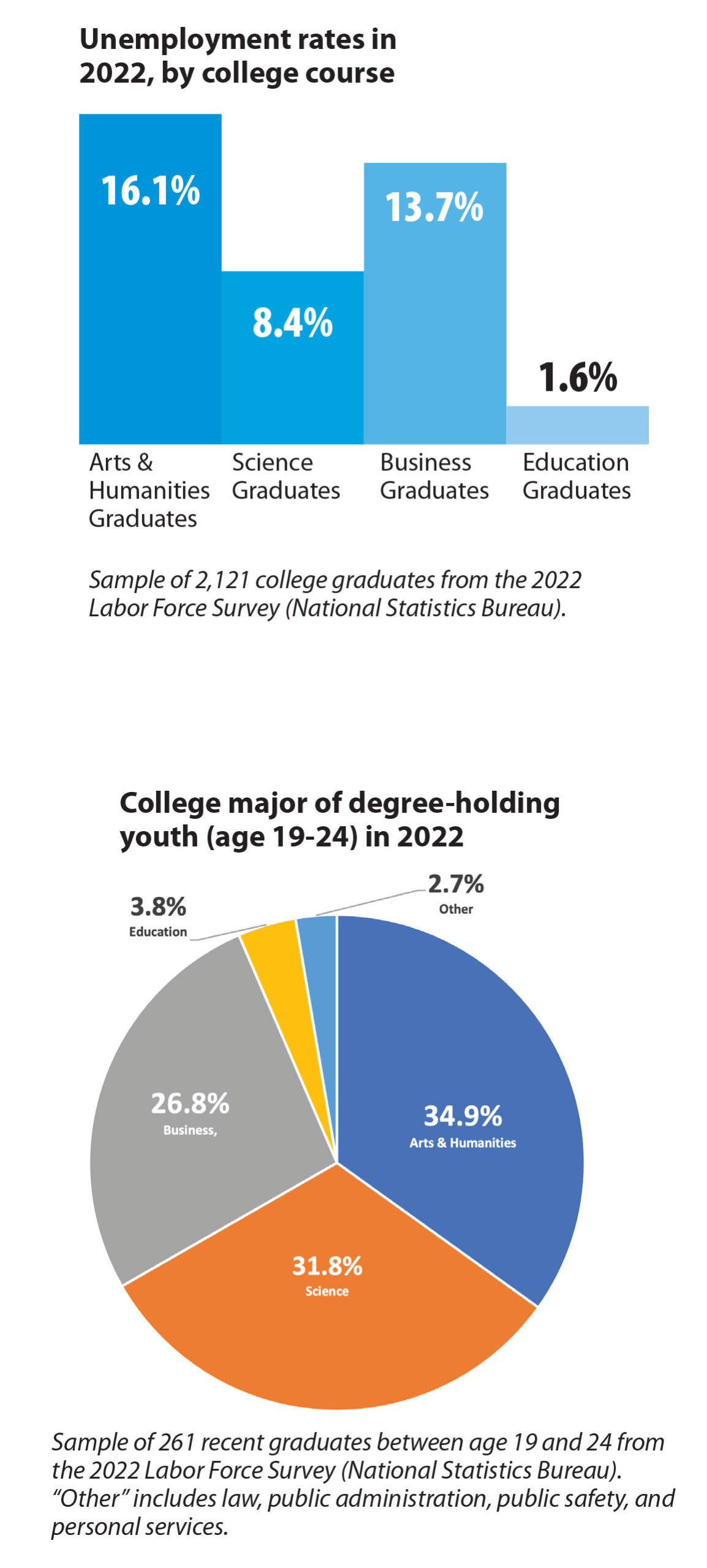This year marks the 40th anniversary of the first tertiary education institution in Bhutan. In 1983, Sherubtse Junior College was upgraded to Sherubtse College, and began awarding undergraduate degrees. Another historic landmark was the celebration of the 20th anniversary of the Royal University of Bhutan (RUB) this past June. A high share of the population (42%) is younger than 25 years old. Bhutan’s tertiary education institutions are critical for preparing those youth for the changing job market.
Nearly one-third of Bhutan’s youth (age 15 to 24) are unemployed. While some economic indicators like Gross Domestic Product have recovered steadily since the country reopened in September 2022, youth unemployment has gone in the other direction. The youth unemployment rate worsened from 11% in 2019, to 23% in 2020, 21% in 2021, and 29% in 2022. In the past year, over 14,000 Bhutanese have migrated to Australia in search of academic and work opportunities. The high youth unemployment rate is a result of several factors, including mismatch between the demand for and supply of skills, the quality and relevance of tertiary education and technical and vocational education and training (TVET) programs, predominance of the hydropower sector and state-owned enterprises, and the small size of the private sector.
The changes in the Arts & Humanities programs at the tertiary level announced in early 2023 are part of RUB’s efforts to enhance the employability of youth. When RUB released its list of undergraduate and diploma courses in January 2023, it removed some Arts & Humanities programs like the Bachelor of Arts degrees in Dzongkha, English, Media Studies, and History. New courses including degrees in Digital Communication and Project Management, Data Science and Analytics, and Economics and Political Science were offered in their stead. These changes are intended to provide more job-relevant education options for college students.

Based on an analysis of the latest Labor Force Survey (conducted in September 2022), Arts & Humanities graduates (who studied languages, classics, social and behavioral studies, or media) do face greater hurdles in the labor market than graduates from Science courses (science, medicine, mathematics, statistics, engineering, agriculture, or computers). Arts & Humanities graduates are 8 percentage points more likely to be unemployed than Science graduates (16.1% vs. 8.4% unemployment rate). But the unemployment rate of Science graduates (8.4%) is still higher than that of the general population (5.9%). This is a signal that unemployment is a widespread issue for college graduates (especially in the aftermath of the COVID-19 pandemic), and tweaking course offerings alone is likely to have limited benefits for employment.
It is important to take a nuanced approach to analyzing the employability of graduates of different courses. The average income for Arts graduates is not significantly different from that of Science graduates. And while Arts & Humanities graduates are more likely to be unemployed than Science graduates, that is mostly true for younger graduates. The employment disadvantage of Arts & Humanities students is almost entirely due to recent graduates (those who are less than 30 years old, and therefore completed their degree within the past decade). For older Arts & Humanities graduates, the employment disadvantage is non-existent. This is an unsurprising indication of how the employability of different college degrees changes with the times.
As reforms to the tertiary system continue in response to the evolving global labor market, it will be essential to take a forward-looking approach to course offerings. For some degrees, like medicine and education, the employment rate of graduates has always been and will continue to be very high. For others, employability will vary over time.
Currently, about 35% of youth have an Arts degree, while 32% have a Science degree. That balance will now shift. But the demand for labor is just as important as the supply of labor, and as the share of Science graduates increases, there may not be enough domestic science jobs to absorb them. Arts graduates may become more in-demand as they become relatively scarce. This is especially possible with the rise of artificial intelligence, which may increase the demand for complementary skills that are conferred in Arts courses, such as critical thinking.
Given the unpredictability of future labor market needs, it is important to maximize student choice so that they can take courses that match their personal aptitudes and fulfill their aspirations. All higher education programs – whether college or TVET, Arts or Science – must produce graduates who are analytical thinkers and lifelong learners, able to adapt to new technology and changing job profiles. In addition, investments in soft skills, communication skills, and emotional intelligence will make Bhutan’s graduates more marketable at the global level so that their opportunities are not limited to the domestic labor market.
Contributed by
Sonam Lhendup and Milan Thomas (@drukonomist)
This article does not
reflect the view of the Asian Development Bank.

